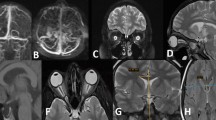Abstract
Purpose
We hypothesized that epilepsy associated with temporal pole encephaloceles (ETPE) could be the consequence and an unrecognized manifestation of idiopathic intracranial hypertension (IIH). To test this hypothesis in patients with ETPEs we evaluated: 1) the frequency of two radiological signs of IIH and 2) whether these patients develop over time clinical manifestations suggestive of elevated intracranial pressure (ICP).
Methods
Case-control study comparing two cardinal radiological signs of IIH pituitary gland height (PGH) and the diameter of the two optic nerve sheaths (ONS) between 29 patients with ETPEs (TPE group) and 29 patients with focal epilepsy of other etiologies (control group), adjusted by age, sex, body mass index (BMI), age at epilepsy onset and epilepsy duration. Analysis was performed using conventional and ordinal logistic regression. The measurements in both groups were compared with validated radiological criteria of IIH.
Results
Of the patients 17 (63%) in the TPE group had all three measurements over the cut-off values for IIH, while no patients in the control group had all three findings. The TPE group patients had lower PGH (3.2 ± 1.0 mm vs. 4.9 ± 1.3 mm, p < 0.001) and larger diameter of ONS than controls (p < 0.001), being similar to validated data of IIH. No patient with TPE had clinical manifestations of elevated ICP (mean follow-up 15.1 ± 11.7 years).
Conclusion
Patients with ETPEs frequently had radiological signs of IIH while not developing typical manifestations of elevated ICP over time. In this way, ETPEs could be an unrecognized manifestation of IIH, and temporal lobe seizures the only clinical expression of this epilepsy syndrome.


Similar content being viewed by others
References
Abou-Hamden A, Lau M, Fabinyi G, Berkovic SF, Jackson GD, Mitchell LA, Kalnins R, Fitt G, Archer JS. Small temporal pole encephaloceles: a treatable cause of “lesion negative” temporal lobe epilepsy. Epilepsia. 2010;51:2199–202.
Toledano R, Jiménez-Huete A, Campo P, Poch C, García-Morales I, Gómez Angulo JC, Coras R, Blümcke I, Álvarez-Linera J, Gil-Nagel A. Small temporal pole encephalocele: a hidden cause of “normal” MRI temporal lobe epilepsy. Epilepsia. 2016;57:841–51.
Gasparini S, Ferlazzo E, Pustorino G, Ascoli M, Cianci V, Sueri C, Calabrò S, Campello M, Africa E, Gangemi A, Versace P, Aguglia U. Epileptogenic role of occult temporal encephalomeningocele: Case-control study. Neurology. 2018;90:e1200–3.
Saavalainen T, Jutila L, Mervaala E, Kälviäinen R, Vanninen R, Immonen A. Temporal anteroinferior encephalocele: an underrecognized etiology of temporal lobe epilepsy? Neurology. 2015;85:1467–74.
Urbach H, Jamneala G, Mader I, Egger K, Yang S, Altenmüller D. Temporal lobe epilepsy due to meningoencephaloceles into the greater sphenoid wing: a consequence of idiopathic intracranial hypertension? Neuroradiology. 2018;60:51–60.
Campbell ZM, Hyer JM, Lauzon S, Bonilha L, Spampinato MV, Yazdani M. Detection and characteristics of temporal encephaloceles in patients with refractory epilepsy. AJNR Am J Neuroradiol. 2018;39:1468–72.
Hoffmann J, Huppertz HJ, Schmidt C, Kunte H, Harms L, Klingebiel R, Wiener E. Morphometric and volumetric MRI changes in idiopathic intracranial hypertension. Cephalalgia. 2013;33:1075–84.
Wall M, Kupersmith MJ, Kieburtz KD, Corbett JJ, Feldon SE, Friedman DI, Katz DM, Keltner JL, Schron EB, McDermott MP; NORDIC Idiopathic Intracranial Hypertension Study Group. The idiopathic intracranial hypertension treatment trial: clinical profile at baseline. JAMA Neurol. 2014;71:693–701.
Headache Classification Committee of the International Headache Society (IHS). The international classification of headache disorders, 3rd edition. Cephalalgia. 2018;38:1–211.
R Core Team. R: a language and environment for statistical computing. Vienna, Austria: R Foundation for Statistical Computing; 2013.
Pérez MA, Bialer OY, Bruce BB, Newman NJ, Biousse V. Primary spontaneous cerebrospinal fluid leaks and idiopathic intracranial hypertension. J Neuroophthalmol. 2013;33:330–7.
Paule E, Freiman TM, Strzelczyk A, Reif PS, Willems LM, Wagner M, Zöllner JP, Rosenow F. Characteristics of bilateral versus unilateral temporal encephalocele-associated epilepsy. Seizure. 2019;71:13–9.
Lenck S, Radovanovic I, Nicholson P, Hodaie M, Krings T, Mendes-Pereira V. Idiopathic intracranial hypertension: the venoglympathic connections. Neurology. 2018;91:515–22.
Bruce BB, Kedar S, Van Stavern GP, Corbett JJ, Newman NJ, Biousse V. Atypical idiopathic intracranial hypertension: normal BMI and older patients. Neurology. 2010;74:1827–32.
Hartmann AJ, Soares BP, Bruce BB, Saindane AM, Newman NJ, Biousse V, Peragallo JH. Imaging Features of Idiopathic Intracranial Hypertension in Children. J Child Neurol. 2017;32:120–6.
Funding
This research did not receive any specific grant from funding agencies in the public, commercial or not-for-profit sectors.
Author information
Authors and Affiliations
Corresponding author
Ethics declarations
Conflict of interest
J. Martinez-Poles, R. Toledano, A. Jiménez-Huete, I. García-Morales, Á. Aledo-Serrano, C. Anciones, P. Campo, J. Álvarez-Linera and A. Gil-Nagel declare that they have no competing interests.
Ethical standards
All procedures performed in studies involving human participants were in accordance with the ethical standards of the institutional and/or national research committee and with the 1964 Helsinki declaration and its later amendments or comparable ethical standards. Informed consent was waived due to the retrospective nature of the study. Consent for publication was waived for this anonymized retrospective study.
Additional information
Javier Martinez-Poles and Rafael Toledano contributed equally.
Rights and permissions
About this article
Cite this article
Martinez-Poles, J., Toledano, R., Jiménez-Huete, A. et al. Epilepsy Associated with Temporal Pole Encephaloceles. Clin Neuroradiol 31, 575–579 (2021). https://doi.org/10.1007/s00062-020-00969-0
Received:
Accepted:
Published:
Issue Date:
DOI: https://doi.org/10.1007/s00062-020-00969-0




